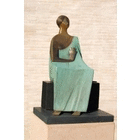
What material is suitable for interiors? What about exteriors?
There are no particular requirements for interiors and all materials are fine.
Frost-proof materials are more suitable for exteriors and are more resistant.
Non frost-proof materials include granite, basalt, quartzite and travertine.
How do I choose the right colour?
It depends mostly on your personal taste and on what will surround the pieces/items.
The best option is to look at the room or area the marble will be used in (or look at photographs) and choose, together, the most suitable materials.
Ask us for advice and we will find the perfect combination.
How do I clean marble?
Use a wool cloth with alcohol for the best results.
Apply neutral polish when you have finished cleaning.
NEVER use acid detergents because they can damage the surface shine and change the colour of the marble.
How do I clean smog-soiled exteriors or areas with moss?
If your exteriors are made with resistant materials (such as granite) use a (water) pressure cleaner or specific detergents if you do not have that type of cleaner.
Graffiti have been painted on my exteriors, what should I do?
The best thing to do is pre-treat the soiled surface with invisible films that remove the stains rapidly and without a trace.
If the surface was not pre-treated you should employ a specialised company.
Call us and we will restore your marble to its original condition.
How do I keep my granite/marble in good condition?
Every 4/6 months (depending also on “wear”), after washing, you should treat the surface with a hydro-repellent that prevents stains.
How can I avoid wear on stairs and door thresholds?
There is no problem really if not many people use the door or the stairs (e.g. a home).
If the general public uses the stairs or door, granite is the most suitable material because it is resistant to wear and does not stain.
To avoid obvious “trodden” patches, the most advisable strategy is to treat the surface (ageing) and make it look “antique”, i.e. the surface is made to look irregular so that the difference between the trodden and “intact” areas is difficult to notice.







